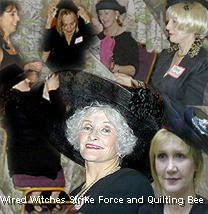 The Hillsborough County Council of Trent aka as the Hiillsborough County School Board and Its Enablers
The Hillsborough County Council of Trent aka as the Hiillsborough County School Board and Its EnablersPlease consider me a formal request for this public information:
A description of the restraint policy with the halters that some children wear on the bus apparently but are forbidden for use in the classroom.
This must be in a policy manual somewhere. Please retrieve it and send it to me.
I also request as public information the terminal reports by the Professional Standards Office for the last five people investigated for charges by the Professional Standards Office.
Lee DD
A Victory for the Constituional Rights of Students lee
Roberts: Court seeks school rule clarity
WHITE SULPHUR SPRINGS, W.Va. | Don't look to the Supreme Court to set school rules, only to clarify them when officials have abdicated that responsibility, Chief Justice John G. Roberts Jr. said Saturday.
At a judicial conference, Chief Justice Roberts was asked how school administrators should interpret seemingly conflicting messages from the court in two recent decisions, including one Thursday that said Arizona officials conducted an unconstitutional strip-search of a teenage girl. In 2007, the justices sided with an Alaska high school principal, ruling that administrators could restrict student speech if it appears to advocate illegal-drug use.
Chief Justice Roberts told the audience there was no conflict in the court's rulings, just clarity intended to deal with narrow issues that surface from government actions.
"You can't expect to get a whole list of regulations from the Supreme Court. That would be bad," he said. "We wouldn't do a good job at it."
In the Arizona case, the high court said school officials violated Savana Redding's rights when they strip-searched her for prescription-strength ibuprofen. The court said educators cannot force children to remove their clothing unless student safety is at risk.
Chief Justice Roberts said administrators should take comfort in the 8-1 ruling, which also found that officials could not be held financially liable when carrying out school policy.
"We recognized that they didn't have very clear guidance," Chief Justice Roberts said. "We laid down a rule about what they can and can't do, but we said they don't have to fork over damages from their own personal funds if they guess wrong."
He also defended the court's diversity - all nine justices are former federal appeals court judges. The issue has surfaced in light of Justice David H. Souter's decision to retire.
Senators from both parties have said the court needs justices who don't come from the federal bench, or the "judicial monastery," as Sen. Patrick J. Leahy, Vermont Democrat, has called it. Mr. Leahy is chairman of the Senate Judiciary Committee, which will begin hearings next month on Judge Sonia Sotomayor's nomination to succeed Justice Souter; she, too, is an appeals court judge.
Chief Justice Roberts said the current justices have a range of legal experience despite their shared background on the appeals level.
"I consider myself a practicing lawyer," the chief justice said, noting he was a judge for only a short time. He served on the U.S. Court of Appeals for the District of Columbia Circuit from 2003 to 2005, when President George W. Bush nominated him to be chief justice.
Other justices have academic and political experience, he said, adding that Justice Clarence Thomas ran a federal agency. "We're also a pretty diverse bunch," he said.
Asked about his desire for more consensus among justices in the court's opinions, Chief Justice Roberts said he wasn't suggesting that justices compromise, but that agreement gives clearer guidance.
"The more we can speak with a broader degree of agreement, it looks a lot more like law," he said.

No comments:
Post a Comment